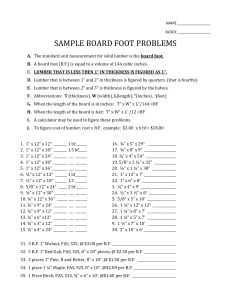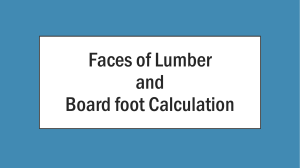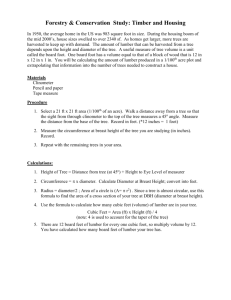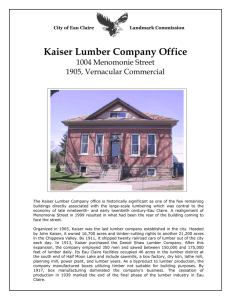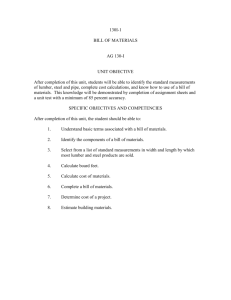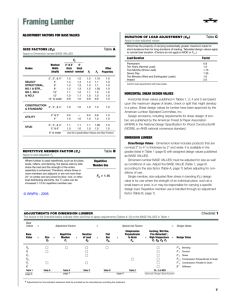No. 42 August, 1989 What Is A Board Foot?
advertisement
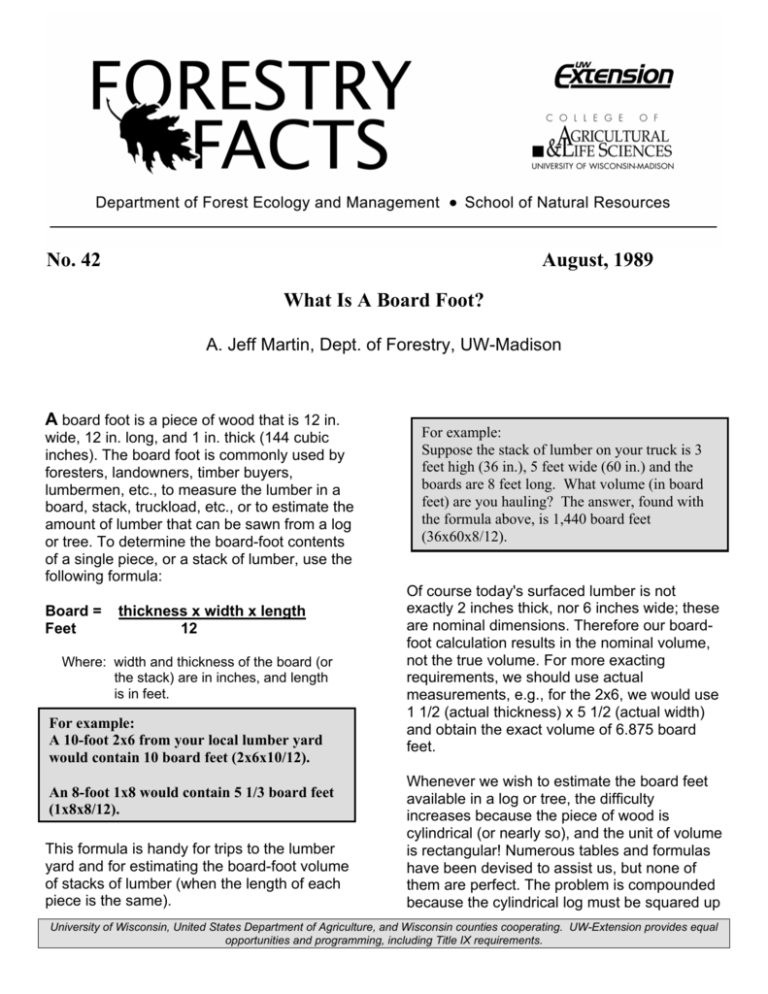
No. 42 August, 1989 What Is A Board Foot? A. Jeff Martin, Dept. of Forestry, UW-Madison A board foot is a piece of wood that is 12 in. wide, 12 in. long, and 1 in. thick (144 cubic inches). The board foot is commonly used by foresters, landowners, timber buyers, lumbermen, etc., to measure the lumber in a board, stack, truckload, etc., or to estimate the amount of lumber that can be sawn from a log or tree. To determine the board-foot contents of a single piece, or a stack of lumber, use the following formula: Board = Feet thickness x width x length 12 Where: width and thickness of the board (or the stack) are in inches, and length is in feet. For example: A 10-foot 2x6 from your local lumber yard would contain 10 board feet (2x6x10/12). An 8-foot 1x8 would contain 5 1/3 board feet (1x8x8/12). This formula is handy for trips to the lumber yard and for estimating the board-foot volume of stacks of lumber (when the length of each piece is the same). For example: Suppose the stack of lumber on your truck is 3 feet high (36 in.), 5 feet wide (60 in.) and the boards are 8 feet long. What volume (in board feet) are you hauling? The answer, found with the formula above, is 1,440 board feet (36x60x8/12). Of course today's surfaced lumber is not exactly 2 inches thick, nor 6 inches wide; these are nominal dimensions. Therefore our boardfoot calculation results in the nominal volume, not the true volume. For more exacting requirements, we should use actual measurements, e.g., for the 2x6, we would use 1 1/2 (actual thickness) x 5 1/2 (actual width) and obtain the exact volume of 6.875 board feet. Whenever we wish to estimate the board feet available in a log or tree, the difficulty increases because the piece of wood is cylindrical (or nearly so), and the unit of volume is rectangular! Numerous tables and formulas have been devised to assist us, but none of them are perfect. The problem is compounded because the cylindrical log must be squared up University of Wisconsin, United States Department of Agriculture, and Wisconsin counties cooperating. UW-Extension provides equal opportunities and programming, including Title IX requirements. and then sawn into lumber, producing waste in the form of slabs and edgings from the sides, and sawdust from the kerf (the sawblade path). If it were possible to obtain our lumber without using a saw, and therefore having no kerf loss, we could obtain exactly 12 board feet from each cubic foot of solid wood. However, with existing technology this isn't possible. Therefore our yield is somewhat less than the ideal; how much less depends for the most part on kerf width, board thickness, and log/tree diameter. In general, for the typical Lake States tree that is sawn for lumber, this would range from about 5-7 board feet per cubic foot. Top Diameter of Log inside bark, inches 6 7 8 9 10 11 12 13 14 15 16 17 18 19 20 21 22 23 24 25 26 27 28 29 30 This Fact Sheet includes a commonly used table for estimating the board-foot volume of logs. The estimates are gross volumes because deductions for rot and other defects must be made to obtain net volumes. To use the table, measure the average diameter of the small end of the log, inside the bark. Then read the volume factor opposite the appropriate diameter/length combination in the table. And finally, multiply this factor by 10 to obtain the gross volume estimate. For example, a 14inch, 10-foot log would contain a gross volume of 70 Bd. Ft. For estimating tree volumes, the reader is referred to UW-Extension Bulletin No. G3332. Board Foot Volume (in tens) by Length, Feet 6 8 10 12 14 16 .5 .5 1 1 2 2 3 4 4 5 6 7 8 9 11 12 13 14 15 17 19 21 22 23 25 .5 1 1 2 3 3 4 5 6 7 8 9 11 12 14 15 17 19 21 23 25 27 29 31 33 1 1 2 3 3 4 5 6 7 9 10 12 13 15 17 19 21 23 25 29 31 34 36 38 41 1 2 2 3 3 4 6 7 9 11 12 14 16 18 21 23 25 28 30 34 37 41 44 46 49 1 2 2 3 4 5 7 8 10 12 14 16 19 21 24 27 29 33 35 40 44 48 51 53 57 2 3 3 4 6 7 8 10 11 14 16 18 21 24 28 30 33 38 40 46 50 55 58 61 66 NOTE: Add a zero (multiply number by 10) to each table figure for actual volume. What Is A Board Foot? , page 2
